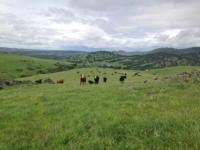Grasslands

California's grasslands are incredibly diverse and home to many species of birds, mammals, insects, and reptiles. More than 300 varieties of native grasses are found statewide, in environments ranging from wet to dry, coast to mountain, desert to forest. These important plants help prevent erosion, improve soil quality, and serve as fire buffers as well as providing texture and beauty in both wild and cultivated landscapes.
Publications
Guide to California Grasslands
This guide, written by members of the California Native Grasslands Association, provides an introduction to publicly-accessible grasslands throughout the state. These short, printable profiles describe: Open Guide
- How to reach the site
- The best times of the year to visit
- What grasses, other plants, and wildlife to look for while you're there
The guide also includes information on each site's ecology and any management or restoration efforts made.
Restoration management for spatially and temporally complex Californian grassland (Spiegal et al. 2014) Read Paper
This chapter in the book “Grassland Biodiversity and Conservation in a Changing World” presents a “management toolkit” to help native plant restoration efforts succeed in the face of environmental variability.
Ecology and Restoration of California Grasslands with special emphasis on the influence of fire and grazing on native grassland species (D'Antonio et al. 2002). Read Paper
The grasslands of California's Mediterranean climate region are unique because they occur within a region where precipitation falls only during the cold part of the year, they have a very strong representation of annual species in their flora and they have undergone a large-scale replacement of native species by European ones over the past150 years. Today, they occupy approximately 10 million ha either as open grassland or as understory in oak-dominated savannas and woodlands (Heady et al. 1992). Forage from these lands provides the grazing resource for range livestock production, a leading agricultural commodity in the State. In addition, California grassland and oak savanna ecosystems are extremely important as wildlife habitat (Guisti et al. 1996) and as a center of high native plant diversity. Indeed, around 90% of species listed in the Inventory of Rare and Endangered Species in California (Skinner and Pavlik 1994), occur within California grassland settings. Despite the value of California grasslands for both range production and native biological diversity, this habitat is increasingly reduced in acreage and quality due to conversion for cropland, residential and urban development and exotic species invasion. As a result, intact native grassland today is among one of the state’s most threatened ecosystems.
Historical Works of California Native Grasses and Grassland Management (Amme 2003). Read Bibliography
This bibliography chronologically charts important research and papers on California’s native grasses and grassland management from the earliest papers by Sampson to the present. As an educational service to its membership, CNGA reproduced many of the earlier, historical out-of-print articles and papers in the style they were originally written. Gradually, the bibliography will expand, as will the number of reproduced papers, presenting important earlier papers as well as recent papers devoted to California native grasses and grassland management.
Grazing for Biodiversity in Californian Mediterranean Grasslands (Bartolome et al. 2014). Read Paper
This paper examines the relationships between grazing and native species biodiversity for selected taxa, groups of species, or communities. For each example, we provide a brief background, then summarize
California Rangelands in Historical Perspective (Burcham 1981). Read Paper
From the paper — "California’s rangeland was the first of her natural resources to be put to beneficial use. Long before the discovery of gold brought this state to worldwide attention, before crops planted by the colonists began to yield dependable harvests, the forage of its rangelands was providing for subsistance needs and beginning to form the basis of a reliable economy. Livestock ranching was the first industry of California. It began on May 14, 1979—two hundred and twelve years ago—when the first Spanish colonists arrived in California. This small band of soldiers and missionaries from Mexico brought about 200 head of cattle, and nearly as many horses, as foundation stock for herds in the colony. Nourished by excellent forage of the California rangeland, the livestock thrived, providing the hardy pioneers with many necessities of life. The settlers also brought some crop and garden plants and agricultural implements. Grain, fruit, and vegetables supplemented products of the rangelands, contributing measurably to the welfare and permanence of the new settlement."
California Grasslands, Ecology and Management (Stromberg, Corbin and D’Antonio 2007)
